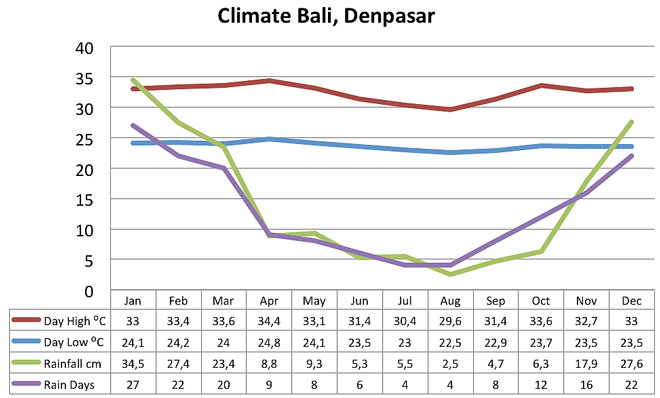Zentral-Bali, Vulkane und Berge
Das zentrale Berggebiet von Bali ist in der Regel kühler und erhält mehr Regen als die tiefer gelegenen Küstenregionen. Insbesondere nachts können die Temperaturen in den Hochländern nahe den Vulkanen deutlich sinken.
Die beliebten Regionen UBUD, SIDEMEN und BATUKARU liegen in einer Höhe von etwa 600-900 Metern (1.970-2.950 Fuß) über dem Meeresspiegel. Diese Höhe führt zu einem kühleren und angenehmeren Klima als den Küstengebieten Balis, die sehr heiß und feucht sein können. Die Temperatur in Ubud beträgt beispielsweise typischerweise das ganze Jahr über 75-85°F (24-29°C), was kühler ist als die Küste (Kuta, Legian, Seminyak, Canggu, Denpasar, Sanur, Bukit Peninsula, Pecatu, Uluwatu, Nusa Dua usw.).
Mount Agung: Dies ist der höchste Vulkan auf Bali und steht auf einer Höhe von 3.142 Metern (10.308 Fuß) über dem Meeresspiegel. Es handelt sich um einen aktiven Vulkan, der in der jüngeren Geschichte mehrmals ausgebrochen ist, zuletzt im Jahr 2017. Der Ausbruch verursachte weit verbreitete Ascheablagerungen und zwang die Evakuierung von Tausenden von Menschen in den umliegenden Gebieten. Mount Agung ist auch ein wichtiger kultureller und spiritueller Ort für die Balinesen, und es wird angenommen, dass er das Zuhause der Götter ist.
Mount Abang: Der Vulkan befindet sich im zentralen Teil von Bali und steht auf einer Höhe von 2.151 Metern (7.057 Fuß) über dem Meeresspiegel. Es handelt sich um einen inaktiven Vulkan und ist genau wie Mount Merbuk kein sehr beliebtes Touristenziel. Der Gipfel des Berges kann durch eine Wanderung in etwa 2,5 Stunden erreicht werden.
Mount Batur: Dieser Vulkan befindet sich im Norden von Bali und steht auf einer Höhe von 1.717 Metern (5.633 Fuß) über dem Meeresspiegel. Es handelt sich um einen aktiven Vulkan, der zuletzt im Jahr 2000 ausgebrochen ist und ein beliebtes Ziel für Wanderer und Trekker ist. Der Vulkan ist auch für seinen wunderschönen Calderasee bekannt, der ein beliebter Ort zum Schwimmen und Bootfahren ist.
Mount Merbuk: Dieser Vulkan befindet sich im nordöstlichen Teil von Bali und steht auf einer Höhe von 1.142 Metern (3.749 Fuß) über dem Meeresspiegel. Es handelt sich um einen inaktiven Vulkan und ist kein beliebtes Touristenziel.
Mount Batukaru ist ein Vulkan, der sich im zentralen Teil von Bali, Indonesien, befindet. Er steht auf einer Höhe von 2.276 Metern (7.470 Fuß) über dem Meeresspiegel und gilt als aktiver Vulkan, der jedoch in der aufgezeichneten Geschichte nicht ausgebrochen ist.
Mount Batukaru ist ein beliebtes Ziel zum Trekking und Wandern, da der Aufstieg zum Gipfel schöne Ausblicke auf die umliegende Landschaft

 English
English Indonesia
Indonesia Français
Français हिन्दी
हिन्दी





